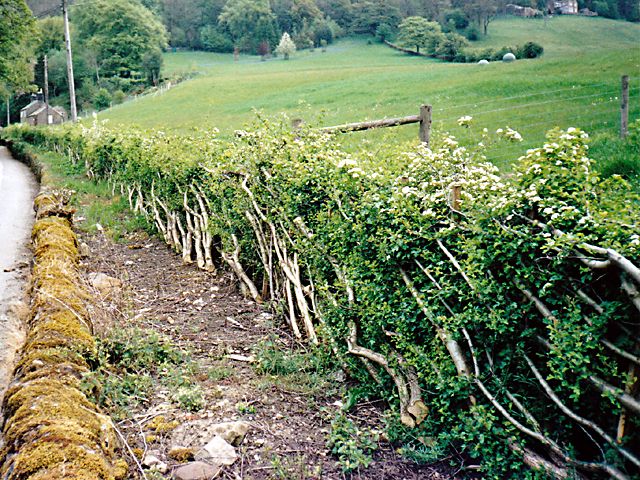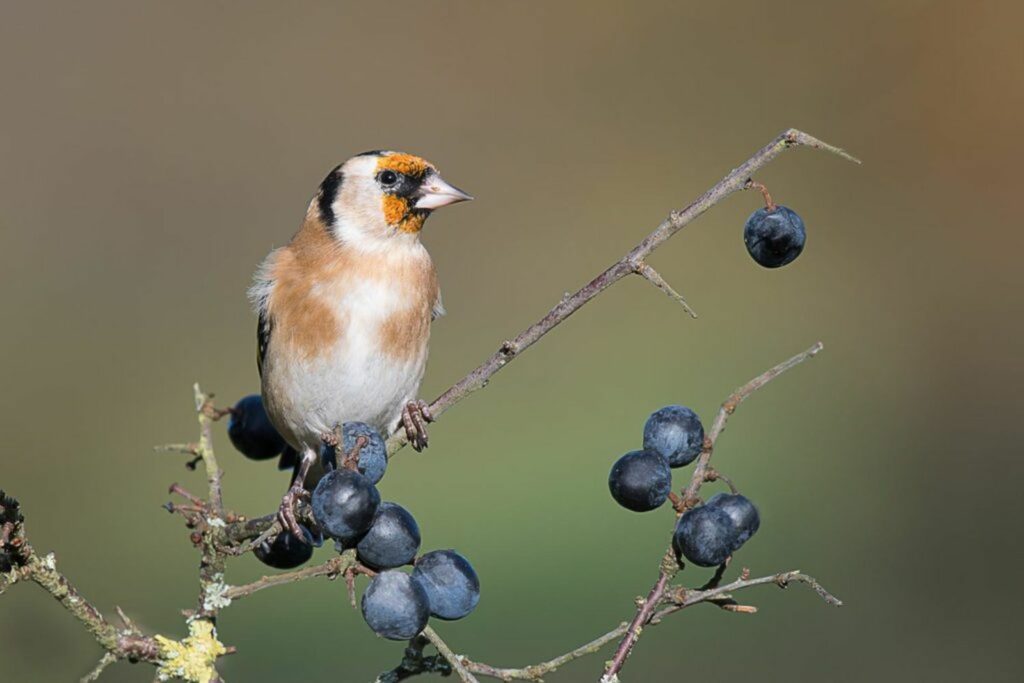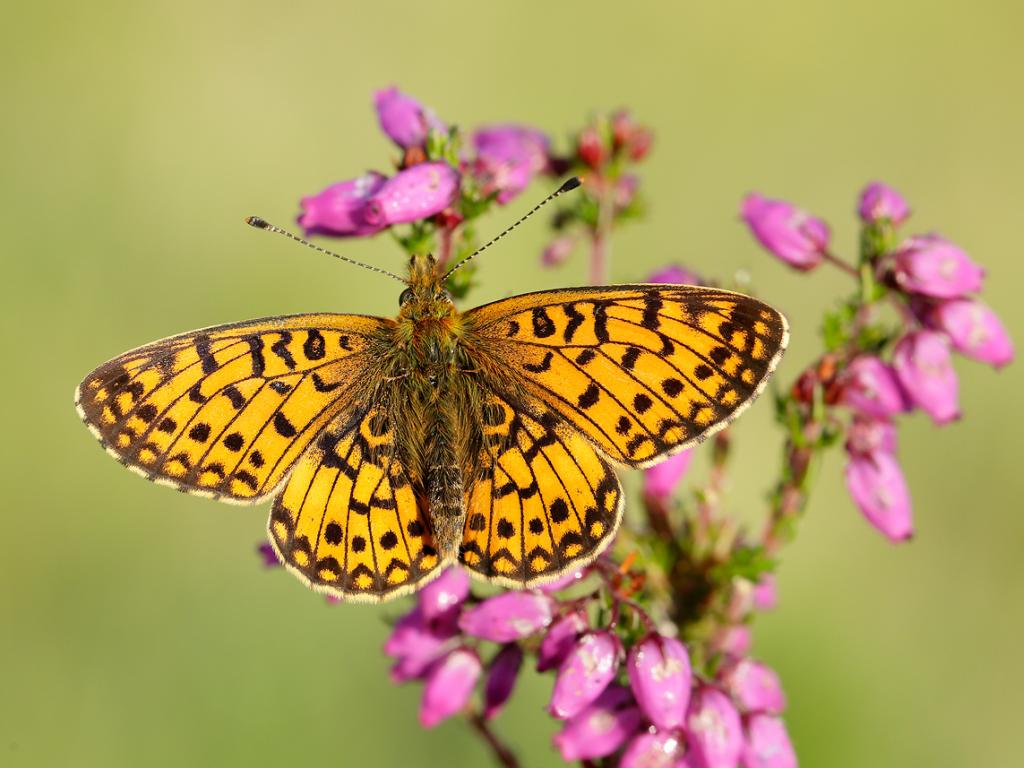
My World |
Gnome Tour |
The Secret World of Gnomes |
British Worlds |
|
|
|
|
|

| 26/01/23 | Beautiful World of Hedgerows | Archive |


Hi guys! I hope you all had a brilliant new year. I've been back at college, and just today we were doing something that really captured my imagination. It's something that's come up before in class, but hasn't been really covered in a while. That is the beautiful world of hedgerows.
Hedgerows are a very traditional form of boundary that consists of straight lines of trees being partially felled one over the other in an interlocking pattern in order to form a boundary. By industry standard this is usually done with 80-90% hawthorn trees, followed by 10-15% blackthorn. The rest can be made up of species such as field maple, dog rose, hazel, and crab apple! There is a very persistent effort in Britain to keep the art of hedgelaying alive, and it's a really underrated form of boundary. There's many different methods to arranging a hedgerow that are found in different areas of the UK, such as the double-brush style of southern England, and the sawn-timber stake style of Derbyshire.
Laying a hedge involves felling the trees within the
There's several reasons for the species selections I described above. Hawthorn is a brilliant species to make up a majority of the hedge for the following reasons:
 Mixing in other species comes from a
Mixing in other species comes from a

One additional thing you can do to enhance the conservation value of a hedgerow is to include
The UK government, under
One of the hardest parts of hedgelaying is getting people on board with the idea, especially farmers who much prefer to flail the canopy without maintaining the hedge's structure. This results in a woody component that is too tall, with a very weak canopy -- the farmer is destroying the part the birds inhabit and nest in! Additionally, there is a recurring issue of people forgetting to come back and actually lay the hedge once it has grown to the appropriate age. This results in a literal row of trees, with no understorey coverage and therefore much less benefit. Not great. One thing that really turns farmers off from hedgerows is how long they take to actually be usable. They need at LEAST five years to be of pleaching age, after all. However, this can be remedied by the construction of a stock fence on both sides of the hedgerow, meaning there is still a physical barrier that doubles in purpose by protecting the young trees from grazing and browsing by creatures such as rabbits, livestock, or deer.
| 15/12/2022 | SNO GAIN!!! | Archive |


Hello! It's been a while since my last blog update. I've been very distracted by other things lately, but I was too excited about recent developments to NOT share how things are going! So, on December 11th we had our first proper snowfall. It laid down very thick and crunchy underfoot. Snow here around Christmas time is frankly pretty rare, and although it's doubtful it'll last to Christmas day, I'm still really glad we've gotten some. As of today, it's still here, and we got more in my village earlier! Although I was out, so I did miss it. This is Sad.


So, I'm writing today to share some practical management I did in class for my last day of college. We were at an ex-plantation site that is a valuable habitat to the small pearl-bordered fritillary. The butterfly is of high priority and rare in the UK, with its population on the decrease. The site contained wet grassland, birch woodlands, and a LOT of scrub. An area of the site was fenced out to maintain an open grassland for the marsh violet, the larval food of the fritillary mentioned.
 When you're fencing off a grassland area with intentions of keeping it a grassland, it's a good idea to create an 'edge effect' outside of the surrounding fenceline. This is the act of removing trees in order to allow for a steadier gradient of the field layer (the grassland) into the understorey (shrubs) which will then 'curve up' toward the canopy (treetops). Ecotones such as this are extremely valuable in conservation, as the niche habitat provides for a very wide array of both generalist species and unique, niche species. For instance, a healthy shrub layer surrounding the grassland will be appealing to passerine birds, like this robin we saw!
When you're fencing off a grassland area with intentions of keeping it a grassland, it's a good idea to create an 'edge effect' outside of the surrounding fenceline. This is the act of removing trees in order to allow for a steadier gradient of the field layer (the grassland) into the understorey (shrubs) which will then 'curve up' toward the canopy (treetops). Ecotones such as this are extremely valuable in conservation, as the niche habitat provides for a very wide array of both generalist species and unique, niche species. For instance, a healthy shrub layer surrounding the grassland will be appealing to passerine birds, like this robin we saw!
We also saw a group of thrushes flying about when we arrived, and thrushes like to feed on seed heads. The field was abundant with these and it's absolutely most likely that the thrushes were planning to come in to the grassland to eat before we arrived. This just goes to show how valuable to nature a grassland can be even during the winter!

Clearing out open spaces in woodlands, even though it seems antithetical to woodland conservation, is overall extremely beneficial as it can drastically increase biodiversity for the woodland at large, even if it means some of the woodland itself is lost. When woodlands form a dense, tall canopy it starves any new growth within the woodland, meaning the vertical structure of the woodland will be the same throughout. You can actually see this in one of the images above -- all the trees are of an equal height! A perfectly consistent vertical structure like this ruins the integrity of the woodland by making it more susceptible to strong winds. This combined with the dense canopy (outside of winter, of course) means that there would be a very weak understorey/field layer in that area. This genuinely makes it a poor habitat.
A great way to introduce more value to this site would be to select specific trees within it to fell on a rotational basis, creating small glades throughout. This would allow light to travel to the field layer and support the growth of herbaceous plants, shrubs, and younger trees (which, it may be a good idea to encourage species such as birch and oak into this area). It would also be a great idea to leave some of the arising deadwood on the site as another habitat. I plan to create a page on the value of different types of deadwood in terms of conservation in the nature area of my site. Having varying age structure means that the canopy and understorey will have varied height and coverage, which makes it a more effective and appealing habitat to all sorts of wildlife!


Another very interesting thing on the site is this area here. The woodlands were cleared out in order to place the power line you can see running through the field, and it's about balanced on each side in terms of size. It succeeded into a very interesting little patch of grassland!
You can see in the second photograph that some heather has grown on the site. Along with this, we also saw bilberry and a lot of bracken. These are very typical species of an acidic heathland! While heather is usually associated with man-made heathlands, it is important to remember that heathland is, naturally, a component of the shrub layer in woodlands. It thrives on nutrient-poor, acidic soils.
We didn't originally consider clear, open spaces to be conservationally valuable until we realised, from having to clear it out for human structures like the power line, how much biodiversity it brings with it. Now they're an important part of woodland management.
Heathlands are one of the most interesting habitats to me, and seeing species characteristic of it in the grassland was really exciting! It's cool to see heather thriving outside of a heathland and to remember how heather might naturally occur.
| 02/11/2022 | Weaver? I Hardly Know 'Er! | Archive |



Lately in our class practicals we have been working on the building of willow revetments aside the river that flows by our campus. The bank had originally been completely covered in invasive Japanese Knotweed and Himalayan Balsam, which destabilised the riverbank and made it vulnerable to being swept away in the current. After successfully clearing the area (the extent of which is seen in the above photos) we began to weave these reventments out of goat willow collected in the nearby inland willow coppice.
Weaving is an ancient practice of creating fast, sturdy, and effective boundaries, and has been practiced for centuries upon centuries. It really doesn't fail! The process involves cutting down trees and using the thicker, older growths (one you can nicely wrap both hands around) to make stakes which are stuck into the ground. Then, new growths (particularly of trees like willow, which have long, flexible green growths) are cut and thinned of leaves, which are then woven in-between the stakes in a S-shape, alternating back to front each time. These are firmly pressed down as far as they will go comfortably, resulting in a very densely-woven boundary.
The purpose of building this revetment was to prevent the bare soil, heavily affected by the invasive species mentioned prior, from eroding and being swept away into the river. It created a nice, accessible and appealing open area that will regenerate with native species overtime.
This was all well and good, but something really enhanced this experience for me, and that was the absolutely torrential rain we had the entire last time we did it. It was HEAVING. I had worn my heavy-duty raincoat, and still got a little damp around the arms. Due to the ground being bare soil, it quickly became extremely slippy, and was genuinely quite dangerous to move about on. I wedged my foot against the stakes in the ground for stability as I wove the willow per our teacher's advice.
I genuinely found the experience really enjoyable! I'm glad I joined in for it. It's fascinating to partake in such a traditional means of management.
| 09/10/2022 | A Mushroom's World? |  |



Today, in honour of yesterday being national fungi day, my local dene had a Fungus Foray! This involved a professional mycologist taking us on a guided walk around the dene, where a group of us (namely me, my classmate, the kids, and the older enthusiasts) would scout out nearby mushrooms off the path and hand them in. The mycologist then went over what species he believed they were, their edibility, and how to identify them! Originally my mam wanted to come, but this morning she was ill and sadly couldn't. I got a lot of photos of the mushrooms both to show her, and to add to the site! I might add them over the next week.
Lately, after the intense dry heat of our 2022 summer, we have gotten random intense spells of rain. This has been amazing for bringing out a huge variety of mushrooms! There was lots to find. I think my favourite mushroom we found was the Dryad's Saddle. This isn't my photo, but the one we found was extremely old and weathered. It's the largest capped mushroom you can find in the UK and in this way is very distinct! It is named after the creatures of Greek myth, the Dryads, who were believed to sit on this comfortable mushroom.

I'm very new to mushrooms, so there's a lot I didn't know. Today I learned about mycelium networks, the way they form, and the unique relationships they can have with trees. The reason some species of mushroom are associated with one species of tree is due to these unique relationships. An example of this would be the jelly ear and elder trees!
All of our fungi were collected in a basket the mycologist carried around with him, for us to further identify when we finished our walk. My friend and I were too exhausted and hungry after the walk to do this part, but as I took many photos and wrote down any names I could, I still have a lot to work with for my own research. It was very fun to have my first Foray into the Fungus World.
| 29/09/2022 | How are you doing? |  |

Hi! This is the first blog-type post I'd like to do on my site. It'd be fun to make little posts to talk about what I've been doing with my course, volunteering, and anything else.
On Tuesday 27th, we went out to a magnesium limestone grassland that was being managed to promote the growth of rock rose. It's the larval food of the Brown Argus butterfly, of which my county has a unique subspecies, so it's good to support them! We worked for four hours on our knees poisoning invasive grass species on the field with sponges glued to plastic tongs. It was a very slow process and I think I know how grazers feel now. It was fun though!
Yesterday for class we learned about Peterken's principles of woodland conservation and management. He basically wrote the bible on that topic! Specifically my group focussed on the importance and impact of open spaces in woodland, including glades, watercourses, and grasslands. From the angle of woodland conservation, Peterken was pretty clear that these are bad things as they take up places where woodland could be -- but the existence of watercourses and open spaces in woodlands significantly boosts the biodiversity of the surrounding woodland by creating new microhabitats, ESPECIALLY bodies of water like ponds or lakes!
We also learned about different rock types -- metamorphic, igneous, and sedimentary -- and their distribution across the UK. Honestly, the soil stuff goes way over my head. I understand there's multiple types, like clay, silt, sand, loam, and also peat and chalk and whatnot, but I easily get caught up in it all. It was definitely interesting though, and I'd like to add the ideal soil types for different trees to my tree ID page. It's a great thing to consider when doing woodland management.
Lastly we did metapopulations. This is the concept of species populations having a network of habitats connected to one another that they migrate between for purposes like overloaded carrying capacity, mating, or fleeing danger. A really good example of this is deer. There tends to be a central source population with the highest quality and suitability of their habitat, which is connected to a web of "sink" populations which are generally of lower quality, and then peripheral populations that are connected to these sinks with no direct line to the source. I'd like to make a page explaining processes like this too but it's very technical.